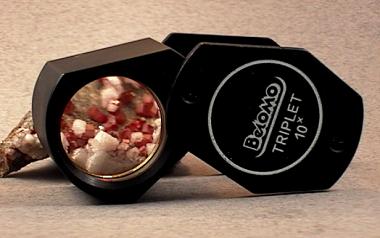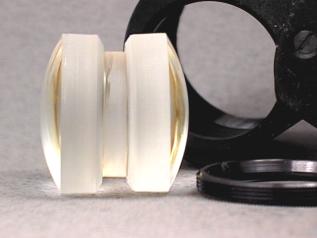Bob's Rock Shop Product Review
The Belomo 10x Loupe
 While making my rounds during the 1998 Tucson Gem and Mineral Show I came across a gonga of a deal on 10x hand loupes which are manufactured in Belarus (a former state of the Soviet Union), and I snapped up a number of them for use as Bob's Rock Shop contest prizes. These loupes turned out to be so desirable that the entire initial batch I purchased for use as prizes "leaked off" to other collectors and faceters of my acquaintance. These Russian triplets are hands down optically superior to the $30 one I kept at home for faceting, so I also filched a Belomo out of the prize units for my own personal use. Well, two of them, actually... ;)
While making my rounds during the 1998 Tucson Gem and Mineral Show I came across a gonga of a deal on 10x hand loupes which are manufactured in Belarus (a former state of the Soviet Union), and I snapped up a number of them for use as Bob's Rock Shop contest prizes. These loupes turned out to be so desirable that the entire initial batch I purchased for use as prizes "leaked off" to other collectors and faceters of my acquaintance. These Russian triplets are hands down optically superior to the $30 one I kept at home for faceting, so I also filched a Belomo out of the prize units for my own personal use. Well, two of them, actually... ;)
The lens housing and covers are machined from metal and assembled with machine screws and
a threaded ring. All of the metal parts sport a durable matte black finish, which I find
to be functionally preferable to the reflective chrome plating that often embellishes more
expensive loupes. A threaded ring secures the compound optical element in its housing, and
the lens covers pivot around in conventional fashion.
The heart of any loupe is of course its lens, and the Belomo provides an exceptional value
in that regard. It employs a large, 21mm (.85") diameter compound lens with 3 elements which
produce an image that is bright and sharp with very low distortion. This general design is
known as an achromatic triplet and it is associated with the highest quality loupes
and lenses in other optical systems such as microscopes and telescopes.
 A simple, or single lens, like the one in the hand magnifier you used as a solar death ray to smoke bugs when you were a kid, is much cheaper and easier to manufacture, and it is often employed in low end and economy optics where the image quality plays second fiddle to cost. Lenses work by bending (refracting) light, and simple lenses suffer from a number of optical aberrations, the worst of which is known as chromatic aberration.
A simple, or single lens, like the one in the hand magnifier you used as a solar death ray to smoke bugs when you were a kid, is much cheaper and easier to manufacture, and it is often employed in low end and economy optics where the image quality plays second fiddle to cost. Lenses work by bending (refracting) light, and simple lenses suffer from a number of optical aberrations, the worst of which is known as chromatic aberration.
Light of different frequencies or wavelengths (ie, different colors) bends at different angles when it passes through a lens, the upshot being that with simple lenses, different colors have different focal lengths. This results in a "halo" like effect that is detrimental to the sharpness, fidelity and overall quality of the magnified image. The shorter the focal length of the lens, the more noticeable this aberration becomes and unfortunately, hand loupes like those used by faceters and mineral collectors employ very short focal lengths.
By combining multiple lenses ground from glasses of different refractive indexes, it is
possible to bring different wavelengths of light to the same effective focal point and
reduce chromatic aberration and its deleterious effects. A compound lens with two elements
is known as a apochromatic doublet, and it can provide significant reduction of chromatic
aberration. Two is better but three is better yet in this regard, and properly designed achromatic triplets provide the best image.
Unfortunately, triplets are also more complex and expensive to manufacture than singles or
doublets, so loupes with achromatic triplets tend to be the most pricey. Loupes are also relatively small and they are easy to misplace and lose, especially in the field or at shows. I've lost my share of them and before I acquired my Belomo loupes, I would have considered the phrase 'expendable triplet' to be an oxymoron. However, thanks to our cash starved comrades in the former USSR, I now own an expendable triplet - it's that $30 chrome plated loupe I used to use for faceting and wouldn't take out of my apartment. I now take that one with me collecting, to shows, club meetings, faceting class, et al. I keep my Belomo(s) at home, as I would rather lose the $30 one than one of my new Russian friends...
If you're even casually interested in microminerals or micromounting but holding off due to the cost of a microscope, do not underestimate the enjoyment to be had from expanding your perceptual and rockhounding horizons with 'just' a decent quality 10x hand loupe! When I first started collecting I had a "bigger is better" attitude and orientation. But as an aesthetic collector, I have come to appreciate that the most sublime and interesting crystals are found in the smaller and often overlooked mineralogical world that is the realm of micromounters and micromineral enthusiasts. If you haven't already, you owe it to yourself to take a look and see...
The Belomo loupe is truly a gonga in this rockhound's book, and if you're in the market for a 10x triplet that just flat outperforms others costing twice as much or more, you will not regret acquiring one of these. This loupe more than holds its own in the quality department and it's got it where it counts. In fact, the Belomo would have to cost significantly more than my old loupe for me to consider buying another one of those over a Belomo. This loupe would also make an affordable yet really appropriate gift that's bound to be appreciated and used by any collector, faceter or jewelry maker. Think stocking stuffers...
So... back to the beginning
Well, press
=>HERE<= |
Jump back to Dominican amber Leap from =>HERE<=
|
 While making my rounds during the 1998 Tucson Gem and Mineral Show I came across a gonga of a deal on 10x hand loupes which are manufactured in Belarus (a former state of the Soviet Union), and I snapped up a number of them for use as Bob's Rock Shop contest prizes. These loupes turned out to be so desirable that the entire initial batch I purchased for use as prizes "leaked off" to other collectors and faceters of my acquaintance. These Russian triplets are hands down optically superior to the $30 one I kept at home for faceting, so I also filched a Belomo out of the prize units for my own personal use. Well, two of them, actually... ;)
While making my rounds during the 1998 Tucson Gem and Mineral Show I came across a gonga of a deal on 10x hand loupes which are manufactured in Belarus (a former state of the Soviet Union), and I snapped up a number of them for use as Bob's Rock Shop contest prizes. These loupes turned out to be so desirable that the entire initial batch I purchased for use as prizes "leaked off" to other collectors and faceters of my acquaintance. These Russian triplets are hands down optically superior to the $30 one I kept at home for faceting, so I also filched a Belomo out of the prize units for my own personal use. Well, two of them, actually... ;)
 A simple, or single lens, like the one in the hand magnifier you used as a solar death ray to smoke bugs when you were a kid, is much cheaper and easier to manufacture, and it is often employed in low end and economy optics where the image quality plays second fiddle to cost. Lenses work by bending (refracting) light, and simple lenses suffer from a number of optical aberrations, the worst of which is known as chromatic aberration.
A simple, or single lens, like the one in the hand magnifier you used as a solar death ray to smoke bugs when you were a kid, is much cheaper and easier to manufacture, and it is often employed in low end and economy optics where the image quality plays second fiddle to cost. Lenses work by bending (refracting) light, and simple lenses suffer from a number of optical aberrations, the worst of which is known as chromatic aberration.